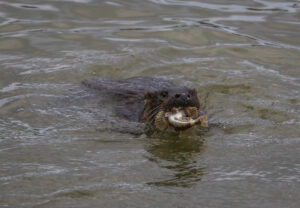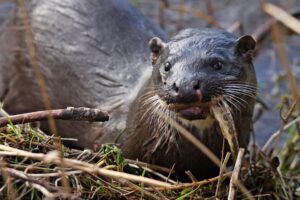Marine Biodiversity
Habitat: Estuary
Species: European otter
Scientific name: Lutra lutra
Size: 60-80cm in length
Colour: grey-brown fur
Distribution: widespread throughout Ireland’s coasts, rivers and waterbodies
The otter is one of Ireland’s top predators, feeding on fish such as eels and salmonids, waterbirds, amphibians, and crustaceans.
The otter is a large mammals with grey-brown fur and a paler chest and throat. Otters are well suited to a life on the water as they have dense fur to keep them warm, webbed feet and they can close their eyes and nostrils when under water. Otters can be distinguished from stout and mink by their much larger size, broader face and broad snout.
Otters are very elusive, however you can spot them at rivers, inland waterbodies and the coast. They require clean waters, an abundant source of food and plenty of vegetation. They dig underground burrows, known as ‘holts’, where they have their cubs. In Ireland, breeding can occur in any season and females will have a single litter annually with 2-3 cubs per litter. Cubs are usually in the water by 10 weeks old and are fully independent at 12 months.
As mentioned, otters can be difficult to spot but there are some signs you can look out for to ascertain if otters are inhabiting an area. Along waterways, keep an eye out for five-toed footprints and droppings! Otters leave droppings in prominent places to help them find mates and defend their territory, the droppings contain visible fish bones and are meant to smell like jasmine tea!

Image by Kya deLongchamps

Image by John Holden

Image by Clodagh Blake
